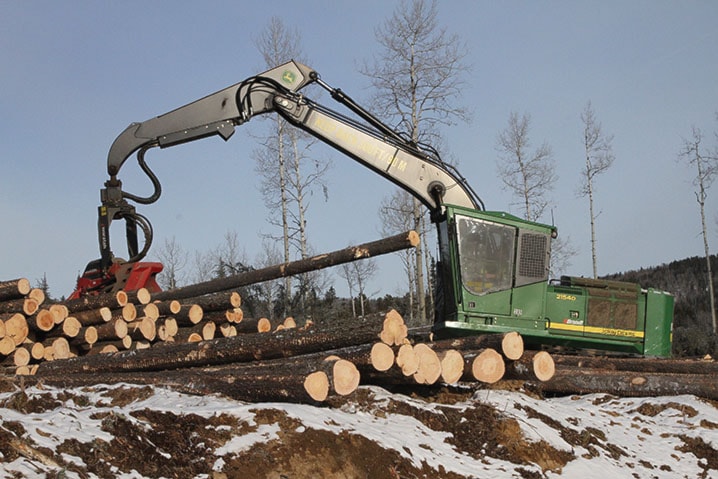ROCKY MOUNTAIN HOUSE — As Alberta’s oil economy tanks another important sector is quietly thriving — forestry.
In the forests between Hwy 11 and the North Saskatchewan River Sundre Forest Products contractors are busy.
“Our economy right now is doing very well,” said Tom Daniels, forestry superintendent for the company, which runs a sawmill and treated wood facility in Sundre and a laminated veneer lumber plant southwest of Rocky Mountain House.
Given rock-bottom oil prices and the resulting havoc in the province’s oil economy “forestry is certainly trying to help maintain that economy at whatever level we can,” says Daniels, during a recent tour of a company’s harvesting area west of Rocky Mountain House.
A couple of significant market forces are at work creating fertile economic ground for foresters, who are behind a $4-billion annual industry in Alberta. Forestry employs 15,000 directly and another 30,000 indirectly.
Since most of Canada’s wood goes to the U.S., it is purchased in U.S. dollars which, because of our weak dollar, goes a lot farther in Canada, where wages and production costs are paid.
As well, low oil prices mean lower fuel costs, which means significant savings in an industry that relies on gas-guzzling heavy machinery that is often running 24 hours a day.
ATB Financial’s first-quarter economic outlook for Alberta makes for grim reading with a half-per cent contraction in gross domestic product predicted for this year.
However, forestry is singled out as one of Alberta’s “star performers.”
U.S. lumber prices slipped a little late last year because of increasing supply but remain close to the 10-year average. The dollar disparity has made a huge difference, but the oilpatch’s problems have also freed up labour supply for forestry.
“As a result, forest product manufacturing is expected to be one of the leading industries in the province this year and next,” says the bank.
While times are good now, the forest industry knows what Alberta’s oil and gas companies are going through.
Forestry was battered by economic forces outside its control in 2007.
“We went through a terrible time,” says Daniels.
While the rest of the country experienced the worst in 2008, the Alberta forestry industry immediately felt the impact of the collapse of new home building in the U.S. a year earlier.
Typically, two million homes are built in the U.S. each year. That dropped below 200,000 in 2007.
“When you think about how big the forestry industry is across Canada and that industry is basically supplying lumber for the U.S. economy.”
When the bottom fell out, a lot of mills shut down and companies went out of business.
Sundre Forest Products, a subsidiary of Quesnel, B.C.-based West Fraser, was in for a rough ride.
“It was survival. We weren’t sure we were going to be able to outlast this downturn.”
However, the industry that emerged from the other side of the downturn was stronger than the one that went in.
“We came out of it in good shape,” he says. “We really got to focus on the core business. What is it that we have to do to make money and what can we strip out of that that we didn’t have to do?
“That really changed the way we look at our cost structure for sure.”
Nation-wide, the forestry industry has developed more flexibility.
“We’re fairly diversified from an economic base. We’re not reliant on just the Canadian economy. We’ve got the ability to move lumber around the world.
“So we’ll find those places where economies are doing well and are able to buy our product.
“There are not a lot of places in the world that are able to produce the product like we have here in Canada. We have a good quality lumber we are able to make here.”
